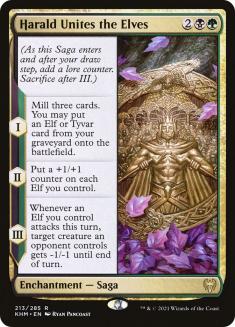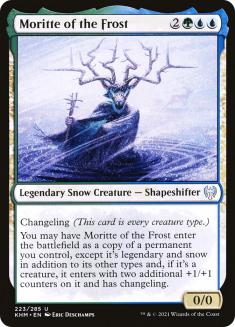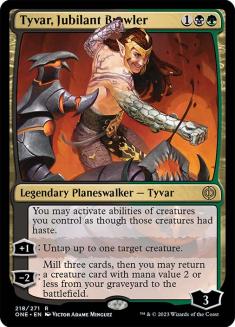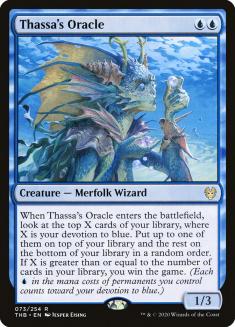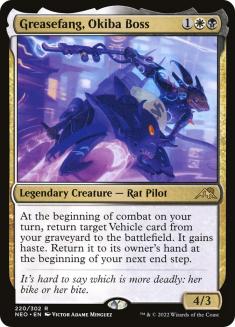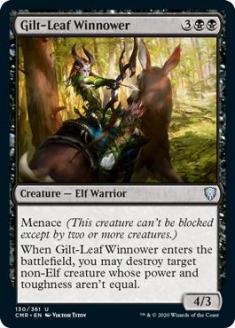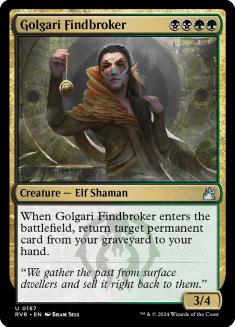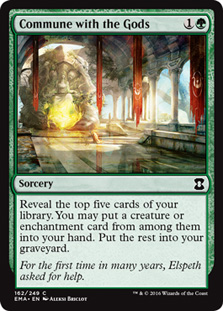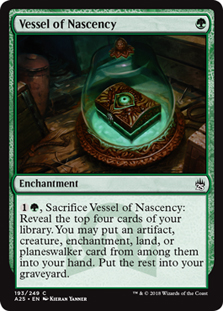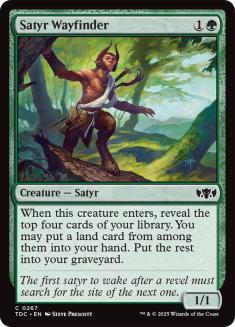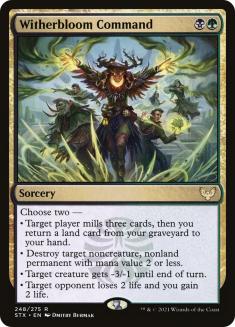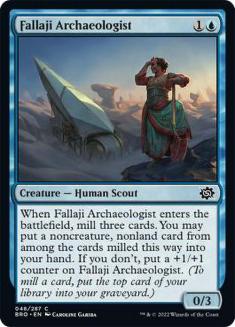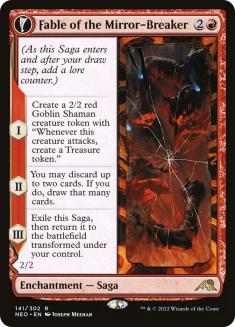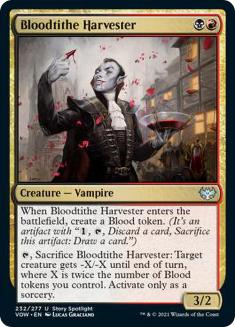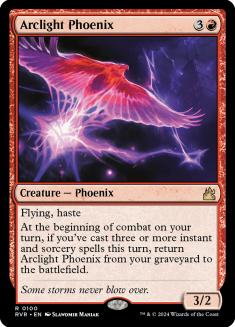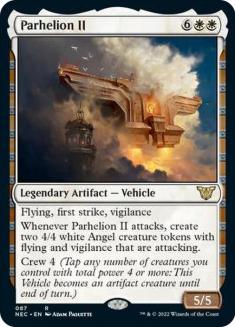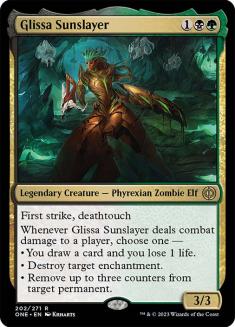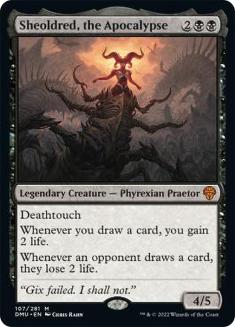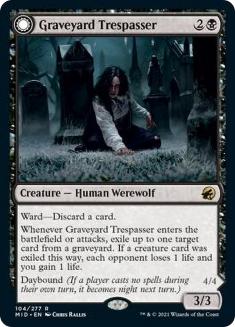This isn’t my first look at wacky Pioneer combo decks and it won’t be my last. The format’s card pool is large and diverse enough that there are plenty of epic experiments on offer, even if few of them are legitimate contenders in the long run. With Pioneer’s return to the Pro Tour this week, what better time for someone to try to throw a curveball?
Today’s treat existed in plain sight for years, but lacked a crucial missing piece until now.
These two cards sat side by side in Kaldheim, but it’s not immediately obvious that they even work together. Let’s go through the motions!
How It Works
We need to resolve Harald Unites the Elves with two copies of Moritte of the Frost in the graveyard.
1) Chapter 1 mills three cards and returns an Elf or Tyvar card – namely Moritte of the Frost, which has all creature types.
2) Moritte copies Harald Unites the Elves, so you now have a real one and a legendary copy on the battlefield.
3) Chapter 1 of the (Moritte) copy mills three cards and returns another copy of Moritte.
4) The new Moritte copies Harald Unites the Elves, so you now have two legendary permanents named Harald Unites the Elves and must sacrifice one.
5) Chapter 1 of the new Moritte copy resolves and looks for an Elf or Tyvar in the graveyard, finding the Moritte that was just put there by the legend rule.
Steps 4 and 5 repeat on loop, milling your entire library three cards at a time.
Okay, You Decked Yourself. Now What?
We’re so used to decking yourself as a precursor to winning the game somehow that it’s easy to forget you need that final step. This combo was legal but unplayable in Standard because there was no remotely efficient way to convert an empty library into a win – and any option would add another card and a lot of mana to your combo requirements.
Enter the secret sauce: Tyvar, Jubilant Brawler!
Suddenly we go from no way to win the game to an amazingly convenient one. Harald Unites the Elves can also return a Tyvar planeswalker, so the final loop can return Tyvar, which returns – what else? – Thassa’s Oracle. It’s impressive how comically unlikely this solution is – another version of a specific fringe planeswalker with a tribal tinge that has to return a non-Elf win condition.
Simplify
We can simplify this to something quite appealing: cast your namesake card with a full graveyard and watch the sparks fly. Combo decks ranging from Replenish and Patriarch’s Bidding back in the day to more recent examples like Command the Dreadhorde have found success with this template.
Stocking the graveyard is simple in Pioneer, and binning both copies of Moritte is much easier than drawing them and having to cast them. The closest comparison might be Greasefang – the enablers that find your combo card also get your other pieces in the graveyard. The enablers that work with Harald Unites the Elves are less versatile – Commune with the Gods is no Grisly Salvage, and there’s no equivalent of Can’t Stay Away – but in return you dodge the removal that plagues Greasefang in most matchups.
Fires of Invention and Enigmatic Incarnation exploit the fact that most decks struggle to remove enchantments; combine that with the lack of graveyard hate in maindecks, and you will face little resistance pre-sideboard.
You don’t need all your ducks in a row immediately, either. If you are under pressure and have to combo right now, you can summon Harald and hope for the best. With only one Moritte in the graveyard, you get two triggers of the first chapter and mill six cards by the time you need the second copy, giving you a lot of looks at it.
Strengthening the Central Saga
Can we make the central Saga into a better fair card? It would be ideal if you could just spend four mana this way to reanimate some expensive Elf in a fair game. Unfortunately, a tribe known for being small in stature with strength in numbers has few individually powerful Elves to offer here, as a quick Scryfall search confirms.
Gilt-Leaf Winnower is a strangely worded Shriekmaw that can deal with Sheoldred, the Apocalypse against Rakdos Midrange or either Valkyrie against Selesnya Angels as well as assorted hits like Adeline, but it’s not a card you want in your deck generally. The real prize might be Golgari Findbroker. If you have nothing better to do, you can cast Harald Unites the Elves returning Golgari Findbroker to buy back another copy – and, if your Saga does get removed by something like Boseiju, Who Endures to break up the chain, the first chapter can return Findbroker instead (as you don’t have to declare the target up-front) to let you try again next turn.
Boosting Backup Sagas
We can also make our backup Sagas better by leaning harder on Tyvar. Maybe you have a redundant Saga but no Morittes yet – you can cast the first copy, mill three cards, and return Tyvar, which can mill three more cards and return something else. If that two-drop is a threat, you’ve added something relevant to the battlefield; if it’s a Satyr Wayfinder, you’ve milled a full ten cards and have probably found at least one Moritte.
Finding the right balance of enablers that fill the graveyard quickly and enablers that find Harald Unites the Elves is difficult. Vessel of Nascency and Commune with the Gods are the best of the bunch in green, while Witherbloom Command is a good blend of self-mill and interaction, especially in post-sideboard games against cards like Unlicensed Hearse.
Choosing Colours
We know we are based in Golgari, but where do we go from there?
Blue joins green as one of the best self-mill colours, with Fallaji Archaeologist and especially Jace, Vryn’s Prodigy as standout enablers and ideal targets for Tyvar. If we are filling our graveyard as fast as possible, Treasure Cruise or Dig Through Time are tempting options too.
With blue mana, we can also just cast Moritte – this will rarely be useful unless it’s kicking off the combo and never something you’re happy to spend five mana on, but it’s better than having it clog up your hand, and if the copy dies, you now have Moritte where you want it.
How about – prepare yourself – Fable of the Mirror-Breaker? It doesn’t fill your graveyard with the same sheer speed or volume as other enablers, but it’s a good discard outlet for drawn Morittes, lets you play a fine fair game, and can be found by other enablers like Commune with the Gods that lack good targets other than Harald Unites the Elves. Once you decide to touch red, Bloodtithe Harvester comes along for the ride and pairs nicely with Tyvar.
A Sultai Sketch
Here’s a first pass at a Sultai list:
Creatures (12)
Planeswalkers (3)
Lands (22)
Spells (23)

This deck will sink or swim based on how much graveyard hate is in the format. There’s much less right now compared to a few months ago, when Izzet Phoenix was on top yet again and Abzan Greasefang was a hot new deck, but that could change if either of those decks – or another graveyard deck that isn’t even on our radar yet – has a good weekend at the Pro Tour.
This deck doesn’t have Greasefang’s obvious backup plan of running the opponent over with Esika’s Chariot. You have to get more creative. Luckily, Pioneer has no shortage of good midrange threats that you can pivot towards post-sideboard – even a new Elf in Glissa Sunslayer! – though it’s unclear how often any of these can win the game singlehandedly if they need to. The red list’s stronger fair game may end up being an important tiebreaker in its favour.
Decks like this can help Pioneer reach the same depth that has kept players so engaged with Modern over the years. There’s a top-tier deck that fits any play style, but also a sea of weird and wacky decks like this just below the surface.


